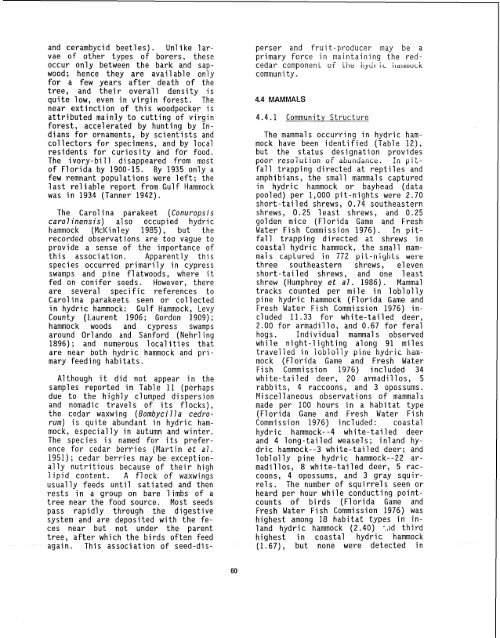The Ecology of Hydric Hammocks - USGS National Wetlands ...
The Ecology of Hydric Hammocks - USGS National Wetlands ...
The Ecology of Hydric Hammocks - USGS National Wetlands ...
You also want an ePaper? Increase the reach of your titles
YUMPU automatically turns print PDFs into web optimized ePapers that Google loves.
and cerambyci d beet1 es) . Unl i ke 1 arvae<strong>of</strong> other types <strong>of</strong> borers, theseoccur only between the bark and sapwood;hence they are available onlyfor a few years after death <strong>of</strong> thetree, and their overall density isquite low, even in virgin forest. <strong>The</strong>near extinction <strong>of</strong> this woodpecker isattributed mainly to cutting <strong>of</strong> virginforest, accelerated by hunting by Indiansfor ornaments, by scientists andcollectors for specimens, and by localresidents for curiosity and for food.<strong>The</strong> ivory-bi 1 l disappeared from most<strong>of</strong> Florida by 1900-15. By 1935 only afew remnant populations were left; the1 ast re1 i able report from Gulf Hammockwas in 1934 (Tanner 1942).<strong>The</strong> Carol i na parakeet (Conuropsiscaro 7 inensis) a1 so occupied hydri chammock (McKinley 1985), but therecorded observations are too vague toprovide a sense <strong>of</strong> the importance <strong>of</strong>this association. Apparently thisspecies occurred primari 1 y in cypressswamps and pine flatwoods, where itfed on conifer seeds. However, thereare several specific references toCarolina parakeets seen or collectedin hydric hammock: Gulf Hammock, LevyCounty (Laurent 1906; Gordon 1909) ;hammock woods and cypress swampsaround Or1 ando and Sanford (Nehrl ing1896) ; and numerous 1 ocal i ti es thatare near both hydric hammock and primaryfeeding habitats.Although it did not appear in thesamples reported in Table 11 (perhapsdue to the highly clumped dispersionand nomadic travels <strong>of</strong> its flocks),the cedar waxwing (Bombyci 1 la cedrorum)is quite abundant in hydric hammock,especially in autumn and winter.<strong>The</strong> species is named for its preferencefor cedar berries (Martin et a7.1951); cedar berries may be exceptionallynutritious because <strong>of</strong> their highlipid content. A flock <strong>of</strong> waxwingsusually feeds until satiated and thenrests in a group on bare limbs <strong>of</strong> atree near the food source. Most seedspass rapidly through the digestivesystem and are deposited with the fecesnear but not under the parenttree, after which the birds <strong>of</strong>ten feedagain. This association <strong>of</strong> seed-dis-perser and fruit-producer may be aprimary force in maintaining the redcedarcomponeni uf iile iiYU;r ;L ;I~I~IIIIUL;Icommunity .4.4 MAMMALS4.4.1 Communitv Structure<strong>The</strong> mammal s occurring in hydri c hammockhave been identified (Table 12),but the status designation providespoor resolution uf ab~:id~~;~t. In pitfalltrapping directed at reptiles andamphi bi ans, the small mammals capturedin hydric hammock or bayhead (datapooled) per 1,000 pit-nights were 2.70short-tai led shrews, 0.74 southeasternshrews, 0.25 least shrews, and 0.25golden mice (Florida Game and FreshWater Fish Commission 1976). In pitfalltrapping directed at shrews incoastal hydric hammock, the small mammalscaptured in 772 pit-nights werethree southeastern shrews, elevenshort-tai led shrews, and one leastshrew (Humphrey et a7. 1986). Mammaltracks counted per mile in loblollypine hydric hammock (Florida Game andFresh Water Fish Commission 1976) included11.33 for white-tailed deer,2.00 for armadillo, and 0.67 for feralhogs. Individual mammal s observedwhile night-lighting along 91 milestravelled in loblolly pine hydric hdmmock(Florida Game and Fresh WaterFish Commission 1976) included 34whi te-tailed deer, 20 armadillos, 5rabbits, 4 raccoons, and 3 opossums.Mi scel 1 aneous observations <strong>of</strong> mammal smade per 100 hours in a habitat type(Florida Game and Fresh Water FishCommission 1976) included: coastalhydric hammock--4 whi te-tailed deerand 4 long-tailed weasels; inland hydrichammock--3 whi te-tailed deer; andloblolly pine hydric hammock--22 armadillos,8 white-tailed deer, 5 raccoons,4 opossums, and 3 gray squirrels. <strong>The</strong> number <strong>of</strong> squirrel s seen orheard per hour whi 1 e conduct i ng poi ntcounts<strong>of</strong> birds (Florida Game andFresh Water Fish Commission 1976) washighest among 18 habitat types in inlandhydric hammock (2.40) -,ld thirdhighest in coastal hydric hammock(1.67), but none were detected in

















